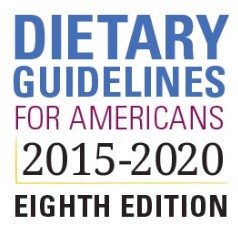They’re better, but still influenced by the food industry…
On January 7, 2016, the U.S. government released the Dietary Guidelines for Americans which is jointly developed every five years by the U.S. Departments of Health and Human Services (HHS) and of Agriculture (USDA). The guidelines serve as a resource to health care professionals, policymakers and the general public by providing nutrition advice for maintaining health and preventing chronic diseases. According to the report “about half of all American adults – 117 million people – have one or more preventable, chronic diseases, many of which are related to poor quality eating patterns and physical inactivity.” This level of chronic illness costs billions of dollars in medical bills and lost productivity annually.
The good news for those of us who thrive on a whole food, plant-based diet is that the guidelines recommend that Americans consume more fruits and vegetables, more fiber and whole grains. The five key guidelines from the report are:
- “Follow a healthy eating pattern across the lifespan. All food and beverage choices matter. Choose a healthy eating pattern at an appropriate calorie level to help achieve and maintain a healthy body weight, support nutrient adequacy, and reduce the risk of chronic disease.
- Focus on variety, nutrient density, and amount. To meet nutrient needs within calorie limits, choose a variety of nutrient-dense foods across and within all food groups in recommended amounts.
- Limit calories from added sugars and saturated fats and reduce sodium intake. Consume an eating pattern low in added sugars, saturated fats, and sodium. Cut back on foods and beverages higher in these components to amounts that fit within healthy eating patterns.
- Shift to healthier food and beverage choices. Choose nutrient-dense foods and beverages across and within all food groups in place of less healthy choices. Consider cultural and personal preferences to make these shifts easier to accomplish and maintain.
- Support healthy eating patterns for all. Everyone has a role in helping to create and support healthy eating patterns in multiple settings nationwide, from home to school to work to communities.”
Key recommendations for a healthy eating pattern include:
- A variety of vegetables from all of the subgroups—dark green, red and orange, legumes (beans and peas), starchy, and other
- Fruits, especially whole fruits
- Grains, at least half of which are whole grains
- Fat-free or low-fat dairy, including milk, yogurt, cheese, and/or fortified soy beverages
- A variety of protein foods, including seafood, lean meats and poultry, eggs, legumes (beans and peas), and nuts, seeds, and soy products
- Oils
A healthy eating pattern limits saturated fats and trans fats, added sugars, and sodium:
- Consume less than 10 percent of calories per day from added sugars (this is 12 teaspoons of sugar per day on a 2,000 calorie diet. Most Americans eat 22 teaspoons per day according to an article in NPR).
- Consume less than 10 percent of calories per day from saturated fats
- Consume less than 2,300 milligrams (mg) per day of sodium
What about Cholesterol?
By law, the guidelines must be based on “the preponderance of current scientific and medical knowledge.” However, they are subject to the influence of big agriculture and food industry special interest groups. According to an article by the Physicans Committee for Responsible Medicine, “in February 2015, the Dietary Guidelines Advisory Committee (DGAC) recommended dropping limits on dietary cholesterol, motivated by industry pressure, according to documents recovered by the Physicians Committee under the Freedom of Information Act. The documents revealed a money trail from the American Egg Board to universities where DGAC members were employed and persistent industry pressure to weaken cholesterol limits.” As a result, PCRM launched a year-long campaign to protest the lowering of the cholesterol limit which paid off.
The guidelines state: “The Key Recommendation from the 2010 Dietary Guidelines to limit consumption of dietary cholesterol to 300 mg per day is not included in the 2015 edition, but this change does not suggest that dietary cholesterol is no longer important to consider when building healthy eating patterns. As recommended by the IOM, [Institute of Medicine], individuals should eat as little dietary cholesterol as possible while consuming a healthy eating pattern.” “Strong evidence from mostly prospective cohort studies but also randomized controlled trials has shown that eating patterns that include lower intake of dietary cholesterol are associated with reduced risk of CVD (cardiovascular disease).” Dietary cholesterol only comes from animal products – eggs, dairy, meat and fish.
What about Processed Meat?
Just three months ago, the World Health Organization’s International Agency for Research on Cancer cautioned “the consumption of red meat as probably carcinogenic to humans and processed meat as carcinogenic to humans.” According to a news article published by NPR on January 7, 2016, New Dietary Guidelines Crack Down On Sugar. But Red Meat Gets A Pass, “The committee had also advised telling Americans to cut back on red and processed meats. But that recommendation sparked a vigorous challenge from the meat industry, and the final dietary guidelines do not include any specific advice to cut back on these sources of protein.”
My conclusion is that you cannot rely on the U.S. Government to provide completely unbiased, evidence-based nutrition advice due to the influence of industry lobbyists. It’s best to do your own research and adopt a dietary lifestyle that helps you maintain and/or improve your health. We hope that plant-based4health.com can provide you with solid evidence-based nutrition advice to consider and support your healthy eating pattern.

